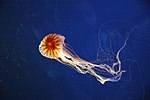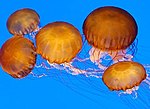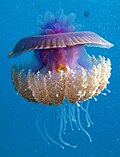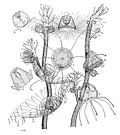A polyp in zoology is one of two forms found in the phylum Cnidaria, the other being the medusa. Polyps are roughly cylindrical in shape and elongated...
13 KB (1,728 words) - 16:49, 16 April 2024
Look up polyp in Wiktionary, the free dictionary. Polyp may refer to: Polyp (zoology) Polyp (medicine) Polyp (cartoonist) This disambiguation page lists...
134 bytes (49 words) - 13:20, 6 June 2019
jellyfish. Some hydroids such as the freshwater Hydra are solitary, with the polyp attached directly to the substrate. When these produce buds, they become...
2 KB (197 words) - 05:15, 7 May 2024
Hydrozoa (redirect from Hydroid polyp)
usually colonial, with multiple polyps connected by tubelike hydrocauli. The hollow cavity in the middle of the polyp extends into the associated hydrocaulus...
17 KB (1,865 words) - 15:51, 5 July 2024
Jellyfish (redirect from Medusa (zoology))
produces planula larvae. These then disperse widely and enter a sedentary polyp phase which may include asexual budding before reaching sexual maturity...
118 KB (12,370 words) - 16:53, 8 June 2024
of polyps that are attached to the sea floor. All the polyps and jellyfish arising from a single planula are genetically identical clones. The polyps form...
25 KB (2,768 words) - 12:18, 15 July 2024
Cnidaria. They typically form compact colonies of many identical individual polyps. Coral species include the important reef builders that inhabit tropical...
110 KB (12,210 words) - 10:57, 1 July 2024
directly into a new polyp. Although the medusa are attached to the polyp, the life cycle resembles that of typical Cnidarian with the polyp reproducing asexually...
3 KB (248 words) - 12:44, 25 April 2024
species produce colonies that are single organisms composed of medusa-like or polyp-like zooids, or both (hence they are trimorphic). Cnidarians' activities...
81 KB (8,929 words) - 16:09, 11 July 2024
subsequently higher ephyra production per polyp, higher percentages of polyp strobilation, and higher polyp survival rate. Polyps will be more successful in warmer...
15 KB (1,517 words) - 16:29, 4 June 2024
Larva (redirect from Larva (zoology))
gemmule In Cnidaria: ephyra, scyphistoma, strobila, gonangium, hydranth, polyp, medusa In Mollusca: paralarva, young cephalopods In Platyhelminthes: hydatid...
15 KB (1,347 words) - 15:16, 10 July 2024
that build themselves a hard skeleton. The individual animals are known as polyps and have a cylindrical body crowned by an oral disc in which a mouth is...
35 KB (4,202 words) - 05:02, 16 May 2024
This is a chronologically organized listing of notable zoological events and discoveries. 28000 BC. Cave paintings (e.g. Chauvet Cave) in Southern France...
57 KB (7,121 words) - 23:29, 1 July 2024
settle and develop into sessile polyps, which subsequently metamorphose into sexual medusae, the oral end of each polyp changing into a medusa which separates...
13 KB (1,175 words) - 14:33, 14 June 2024
single polyp attached to a hard surface by its base, but some species live in soft sediment, and a few float near the surface of the water. The polyp has...
43 KB (4,666 words) - 01:16, 13 July 2024
class of mainly marine and some freshwater animal species that have both polyp and medusa stages in their life cycle. Hydrozoa belongs to the phylum Cnidaria...
12 KB (1,417 words) - 07:20, 15 January 2024
planktonic medusa or polyp form, which is most evident in the warm summer months, and an inconspicuous, but longer-lived, bottom-dwelling polyp, which seasonally...
10 KB (1,152 words) - 17:56, 27 May 2024
reproduction in the polyp stage. Lion's mane jellyfish have four different stages in their year-long lifespan: a larval stage, a polyp stage, an ephyrae...
18 KB (1,869 words) - 08:41, 13 July 2024
of the polyp and the polyp results from sexual reproduction of medusae. In T. nutricula, planktonic medusa have the capability to bud polyps or medusae...
5 KB (589 words) - 23:25, 18 August 2023
polyp of the Scyphomedusa, Sanderia malayensis and its reproduction" (PDF). Journal of the Faculty of Science Hokkaido University. Series VI. Zoology...
6 KB (696 words) - 15:54, 24 November 2023
single polyp develops into a rigid, erect stalk (the rachis) and loses its tentacles, forming a bulbous "root" or peduncle at its base. The other polyps branch...
11 KB (1,091 words) - 14:34, 14 June 2024
Hydra (genus) (redirect from Hydra (zoology))
polyp to an adult form called a medusa, which is usually the life stage where sexual reproduction occurs, but Hydra do not progress beyond the polyp phase...
29 KB (3,303 words) - 10:02, 31 May 2024
In zoology, a mesentery is a membrane inside the body cavity of an animal. The term identifies different structures in different phyla: in vertebrates...
6 KB (655 words) - 15:58, 28 December 2023
Calyx (anatomy) (redirect from Calyx (zoology))
spicules containing the basal portion of the upper tentacular part of the polyp of some soft corals (also called calice). A body part of the Entoprocta...
2 KB (280 words) - 06:41, 10 January 2022
Sessility (motility) (redirect from Sessility (zoology))
become sessile at maturity. Conversely, many jellyfish develop as sessile polyps early in their life cycle. In the case of the cochineal, it is in the nymph...
4 KB (472 words) - 04:15, 24 April 2024
a medusa, as is the case in scyphozoans and some hydrozoans, or from a polyp, as in the case of anthozoans. Depending on the species, the planula either...
5 KB (458 words) - 20:47, 4 July 2024
Zoanthus sociatus (redirect from Button polyp)
Zoanthus sociatus, commonly known as the green sea mat or button polyp, is a zoanthid usually found in shallow reef zones of tropical regions from Caribbean...
4 KB (494 words) - 21:21, 9 May 2023
corallite is the skeletal cup, formed by an individual stony coral polyp, in which the polyp sits and into which it can retract. The cup is composed of aragonite...
4 KB (538 words) - 01:06, 7 November 2022
cycle as other members in the class Scyphozoa. It alternates between a polyp form that reproduces asexually and a medusa form that reproduces sexually...
17 KB (2,221 words) - 15:25, 27 April 2024
can disperse as part of the plankton. The basic unit of the adult is the polyp; this consists of a cylindrical column topped by a disc with a central mouth...
39 KB (3,985 words) - 06:10, 12 January 2024

























